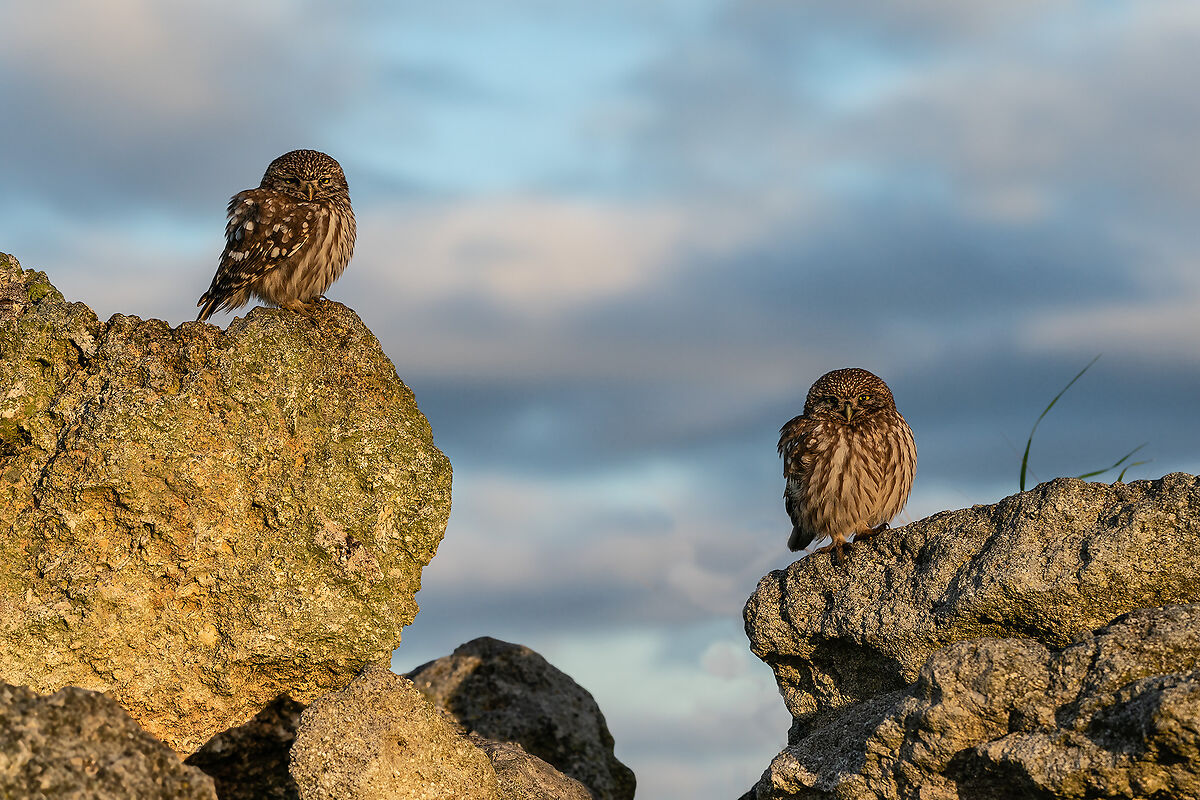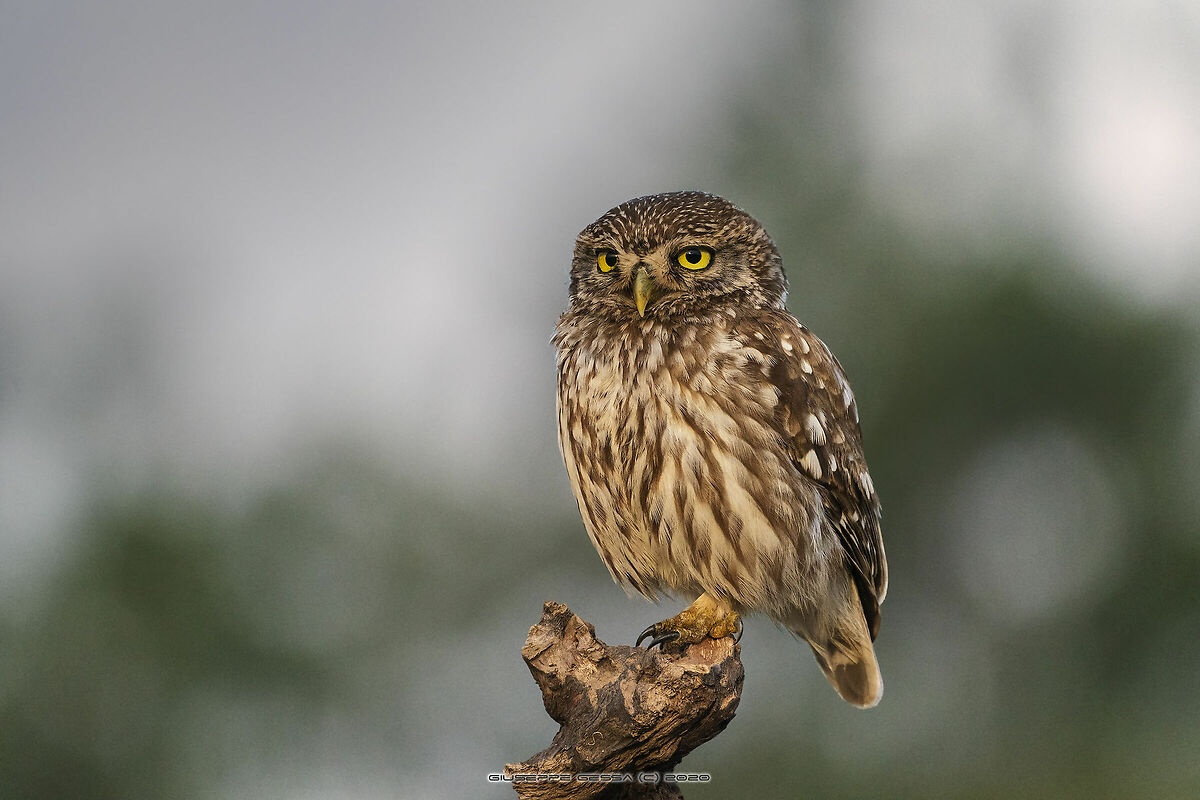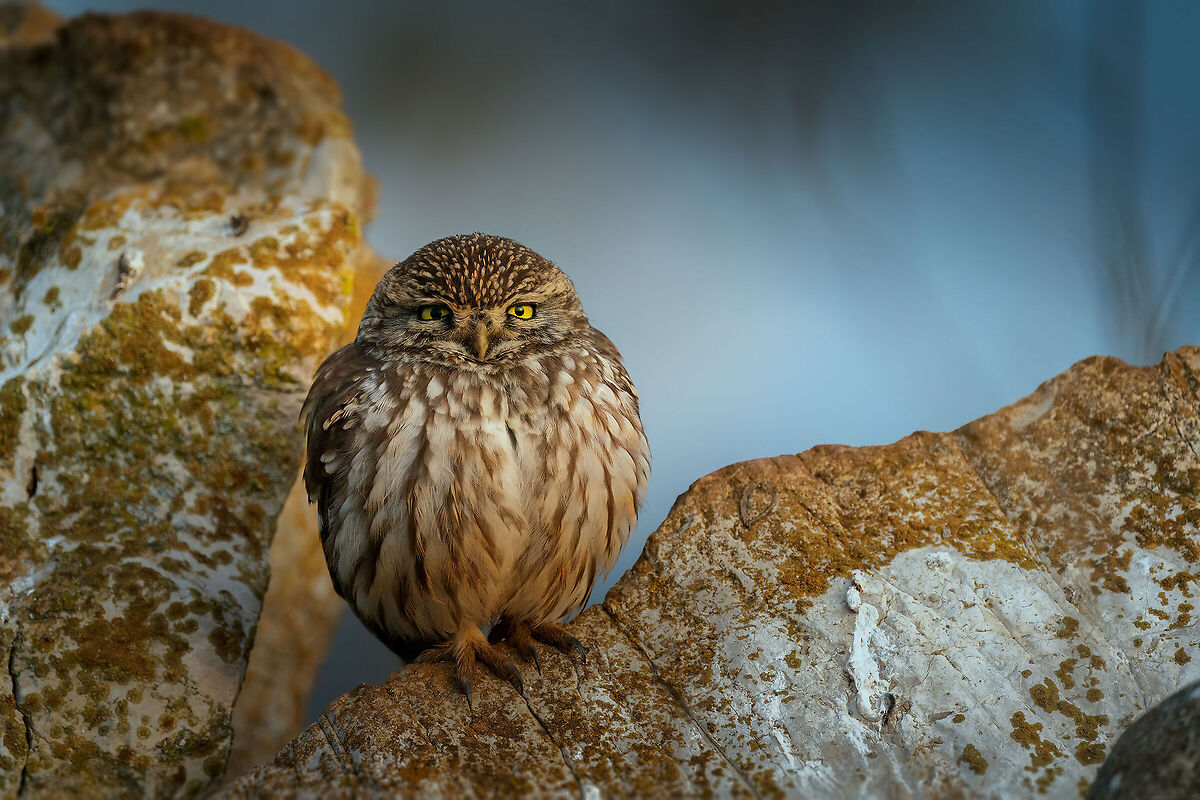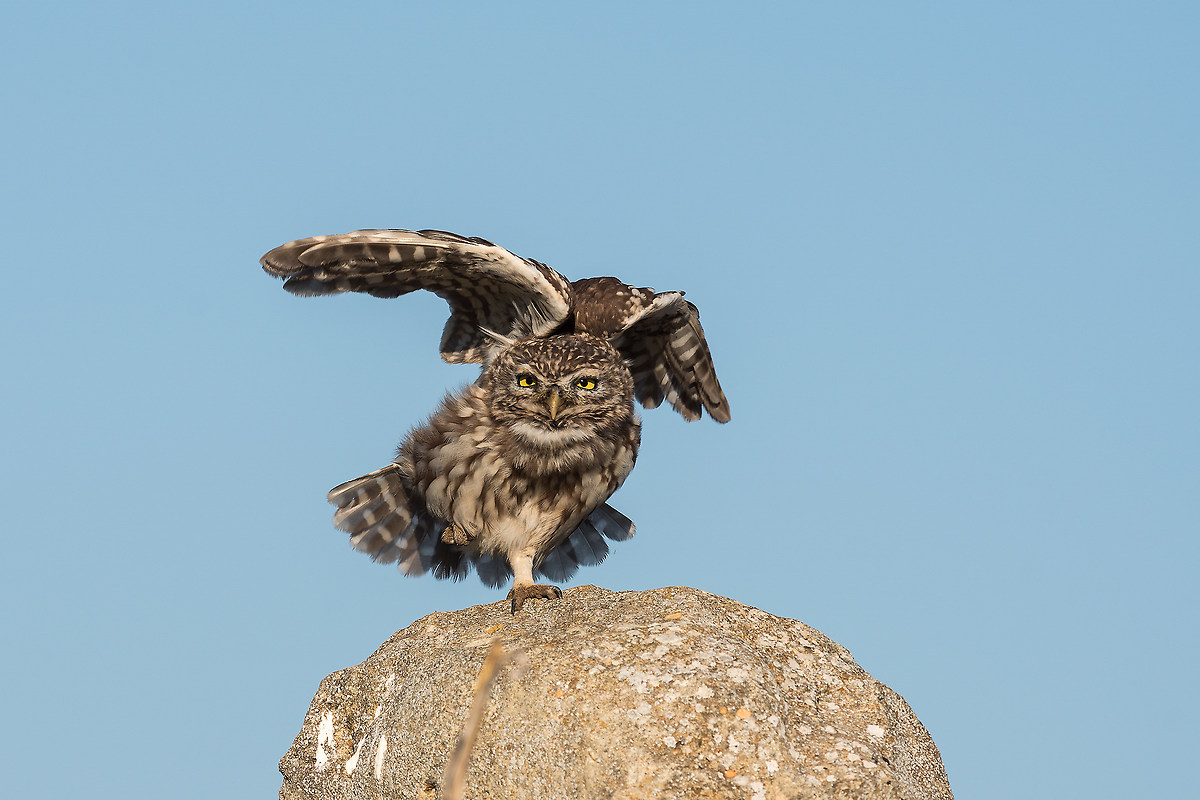How to photograph little owls
How to photograph little owls, testo e foto by
Gundamrx91. Pubblicato il 05 Aprile 2021; 22 risposte, 2005 visite.
Photographing little owls can be challenging, mostly if you don't know where to find them. But I'm going to give you some advice in order to take owls' pictures respecting their safety, that's the most important aspect that you always have to remember. I've already written a short article about photographing the little owls, but this time I'd like to talk about others aspect of how to approach the wildlife.
What to use to hide by the little owls?
In many years of wildlife photography, I've learnt that the little owls are less worried about your presence than you'd be expected. But that doesn't mean that you don't have to care about it. I'll never quit saying that the most important thing, in wildlife photography, is the animals safe. And also in this case everything you do might be dangerous for them, so you have to take every precaution to minimize any trouble. But let's crack on the subject!!
Photo blinds

Photo blinds are essential for photographing the little owls unless you are really lucky to have them at home laughing But it wouldn't be the same thing... Anyway, there are two kinds of photo blind: commercial photo blinds and home-made photo blinds. It all depends on the situation because there might be many problems with using a photo blind. First of all the field where live the little owls. If it is private property it's always good to ask the owner, in order to get permission for building a fixed photo blind, or at least to get on in the field for taking pictures. I'm always honest with the owner and I always tell them the truth and my intention to build a photo blind, explaining that I'll take away everything when I'll finish photographing the owls. As you know that is a long process, and you'll need a long time for achieving your goals, so take in mind to build a sturdy blind, that can resist strong winds and rains, and hide you very well. This is not a write about building a photo blind, but I'll write something about it in the future, so stay tuned.
What's the main reason for building a fixed photo blind? For sure it's more comfortable because you don't need to take every time your portable photo blind, if you have got one. But the most important thing is that the little owls will get used to the presence of the photo blind day by day.
But if you can't build a fixed photo blind so you can only use a portable photo blind.
In the market, there are many models by different brands, but I'd like to advise you to get a Tragopan photo blind. To be honest, they don't pay me for that, but their products are really good and really specific for wildlife photography and I've got one photo blind model really nice, light and useful, that I've been using for many years. Have a look at their website to check what they offer.
Every time I can't build a fixed photo blind, maybe because I don't know the field's owner or the field is really far from home, and I couldn't make the right maintenance, so I prefer to use my Tragopan. And don't forget to take a little chair, if you don't want to sit on the ground sealed
What's the best moment to watch/photograph the little owls?

Little owls can be seen all over the year, fortunately. So, please try to not concentrate your attention only during the breeding season. I know the chicks are really cute, but there is always the chance that something goes wrong, so you should prefer the other period of the year. In my opinion, the best moment is during the spring when everywhere is green, there are flowers and nature is awaking, and, if you are really lucky, you might see the owls mating.
After that, you have found the place, or the nest, where they live/hunt and you've built the photo blind, if you can, the right time to go there and photograph them is during the night. As you know, little owls hunt during the night so they stay far from the next quite a long during that period, giving you the chance to arrive without being seen by them. Usually, I check the sunrise time sunrise the day before going to the owls, and I arrive at the place at least one hour and a half before the sunrise. That because there is always a moment of weak light before the sun come up, a moment where they might see you. And you always have to avoid it.
What behaviour should you have?

Your behaviours will influence the outcome of the photographic session. So I follow two main rules:
I don't put the photo blind too close to the nest, at a maximum of 5 or 6 meters far
I don't speak loud and I try to not make strong noises
But before that, I check for someday, from far with binoculars, the situation to understand their movement. When I have time I go there quite often, in order to be more sure, but if I can't I go only someday before, or at least the day before. After having checked the situation I prepare everything for the photographic session: all my gear, food, water and warm clothes!!! Yes, staying stop for many hours can be really challenging and you need to be always prepared for every weather condition, mostly with home-made photo blind that, usually, aren't protected from the rains.
Actually, there are other rules that you have to follow, such as not using alive prey to attract them. I find that practice really regrettable, even because the little owls often take their prey in the nest. I got some photos with the owls hunting and never using a pour mouse stuck somewhere, as some photographer do. I don't find it really ethical!!
Another aspect that you should think about is that you have to not advertise it, only for protecting them. Too many "wild" photographer get the owls in trouble, and it's never good. It's the same question to stuck alive animals. Many "wild" photographer will do everything for making the "perfect" photo of the year, but that's not the respect of nature.
So, keep in mind, first of all, it comes the owl's security than the photos.
Which lens to use to photograph the little owls

Considering the distance of the photo blind from the nest, you have many choices about which lens to use in wildlife photography. Staying at 5 or 6 meters far, using a 600mm you can almost fill the frame, having a really good image quality (I mean sharpness and bokeh). But I have to also to consider the owls' size, in fact, they are small so you might have a need to use a teleconverter, at least a 1.4x tc in order to have bigger subjects. Of course, having longer telephoto lenses will advantage you in many ways: you might stay further from the nest, or photograph also other small birds during the waiting. As you know prime lenses have the best in term of image quality and autofocus speed, but their fixed focal length could be sometimes a problem, so I prefer to use a zoom telephoto lens, like the Sony 100-400GM, if I'm quite near to the nest, or the Sony 200-600G if I'm further to the nest. With both lenses, I can also use the 1.4x teleconverter, so I can cover many situations, from portraits to landscapes pictures.
But you can also use a wide-angle lens for photographing the little owls, putting the camera very close to the nest, or the perch where they usually go or stay. In that case, should be a good idea to protect the camera with a camouflage neoprene cover for the humidity or the rain, but also for other birds or the little owls themselves. Of course, your camera will be far from you, so you'll need a remote control, like a wireless trigger or a smartphone if your camera allows that kind of connection, for controlling the camera and shooting as you need. In fact, in those situations, I use the Sony Edge Android app for controlling the Sony A7RII, or a wireless trigger, connected to the camera. In the market, there are many brands that offer lots of different models for any needs and pocket tongue-out
When leaving the blind

Ok, it's time to go home, but the owls are still in the nest, or in the perch, so what have I to do? Nothing, you have to do!! Yes, the only chance for not scaring the little owls is waiting until they go away. Maybe they'll so in the nest, or they'll fly somewhere, you can't know it, but that is the right moment. Sometimes happens that a predator, like a buzzard or a marsh harrier, fly above frightening them and to stay safe they might go in the nest, as usual. So if you want to go away is the right moment. You would have to leave the blind quickly. If you are using a fixed blind, won't be a problem storing the camera in the backpack, differently with a portable photo blind you'll need to dismount everything, and it will take more time, so being fast is essential. Of course, there is the chance that the little owls go naturally somewhere, and if after some minute they don't get back, so you can leave the spot quietly.
So, remember, the less they see you, the less they will be in trouble.
Conclusion Ok, I finished with this short guide. Naturally, it isn't exhaustive, there would be others aspect to consider, but to start photographing the little owls I think is enough. I've put the pictures above taken during the years to show you the result of my photo sessions using the techniques wrote before. If you want to ask me something don't hesitate to write at my email or leave a comment in the section below, or for anything else. I also made a video that you can see from my Youtube channel at the following link:
https://www.youtube.com/channel/UC6UTv9F2kOJW99YygmFXtgw
Thanks for reading.
Cheers,
Giuseppe
Risposte e commenti
Che cosa ne pensi di questo articolo?
Vuoi dire la tua, fare domande all'autore o semplicemente fare i complimenti per un articolo che ti ha colpito particolarmente? Per partecipare iscriviti a JuzaPhoto, è semplice e gratuito!
Non solo: iscrivendoti potrai creare una tua pagina personale, pubblicare foto, ricevere commenti, partecipare alle discussioni e sfruttare tutte le funzionalità di JuzaPhoto. Con oltre 242000 iscritti, c'è spazio per tutti, dal principiante al professionista.
user207929 | inviato il 13 Aprile 2021 ore 12:31
Articolo interessante, corredato da belle foto. Non ho molta esperienza con questo tipo di rapaci, come di avifauna in genere, poiché tendo a fotografare di più i mammiferi, ma mi hai fatto venire una certa curiosità. Sono animali bellissimi e particolarmente affascinanti, in effetti.
Complimenti
Vittorio |
| inviato il 13 Aprile 2021 ore 15:01
Grazie Vittorio, sono lieto sia stato interessante. Al contrario io invece ho poca dimestichezza con i mammiferi e le poche foto fatte sono più il frutto della fortuna 
Se nel caso ti interessasse altro sull'argomento chiedi pure  |
user207929 | inviato il 13 Aprile 2021 ore 16:08
Mi appassiona moltissimo un altro strigiforme il Gufo Reale. Sul finire degli anni settanta o forse primissimi anni ottanta, accompagnai un amico nei Piani Eterni (Parco delle Dolomiti Bellunesi) per una settimana circa, il quale aveva l'incarico di riprendere il Reale nel suo ambiente naturale. Lavorava come biologo per un ministero, credo Agricoltura, se non erro, o un ente ad esso collegato. Piazzammo delle fototrappole e facemmo anche dei lunghi appostamenti, con esiti abbastanza scadenti. Premetto che le fototrappole non erano quelle moderne di oggi, ma prevedevano la posa di vere e proprie macchine fotografiche attivate da fotocellule (non saprei definirle meglio, ma più o meno una cosa del genere).
Mi capitò di osservarne uno in particolare, di Gufo Reale, e ancora oggi il ricordo mi emoziona un po'. Ovviamente mi capitò in un momento dove ero privo di fotocamera.
È tanto difficile da riprendere in ambiente naturale? È una curiosità, legata anche al fatto che ho spesso parlato a mia figlia di quell'esperienza, fantasticando con lei di riprovarci assieme, a riprenderlo in quel luogo meraviglioso.
Grazie per l'eventuale risposta.
Vittorio |
| inviato il 13 Aprile 2021 ore 16:46
Come per tutti i rapaci la chiave e conoscere le abitudini e i luoghi di caccia del soggetto. Con le moderne fototrappole ti puoi evitare di andare spesso nella zona dove c'è il gufo, se sei sicuro che non la rubino, altrimenti ci vuole tempo e pazienza, perchè dovrai dedicare un certo di numero di ore settimanali a studiarlo da lontano con un binocolo, giusto per capire dove bazzica 
Una volta trovato, se non vuoi/puoi costruire un capanno, o non ne possiedi uno, l'unica cosa che puoi fare è tentare cercando di stare sempre nascosto alla sua vista, o comunque ad una distanza che non lo faccia scappare, perchè è sicuro che vola via non appena si sente minacciato dalla tua presenza.
Poi se trovi la coppia nidificante allora la cosa cambia, primo perchè hai la sicurezza di sapere di trovarlo con sicurezza, ma anche la delicatezza della cosa, visto che la tua presenza, se troppo invadente, potrebbe far fallire la nidificazione. Infatti in questi casi sconsiglio sempre questo approccio se non si è bene addentro all'argomento, ma di limitarsi di vederlo/fotografarlo da lontano, tanto primo o poi qualche scatto decente si riesce a farlo (la perseveranza premia sempre). |
user207929 | inviato il 29 Aprile 2021 ore 17:26
Cavolo non mi sono accorto che mi avevi risposto. Devo aver aperto la notifica senza accorgermene, quindi senza leggere... Scusami.
Molto interessanti le tue info, ma credo che sarà difficile realizzare il mio sogno. Questo genere di fotografia specializzata richiederebbe un impegno in ordine di tempo di cui non dispongo, purtroppo. Ma io e mia figlia non smetteremo di fantasticare nel merito.
Qualche tempo fa, in una serata tranquilla, un gufo comune è atterrato nella grondaia dei miei vicini di casa, a pochi metri da me e mia figlia. Sembrava per nulla spaventato dalla nostra presenza e abbiamo avuto un discreto tempo per ammirarlo, anche quando è volato in cima al pino del mio giardino, soffermandosi un bel po', incurante della nostra presenza. Mia figlia è rimasta molto affascinata da questa piccola avventura e, a dire il vero, anch'io. In seguito le ho fatto leggere il tuo articolo, dato che dimostrava evidente interesse per l'argomento e le mie chiacchiere nel merito. Beh, ho dovuto cedere e consentirle di portare l'IPad a scuola (9 anni, quarta elementare), poiché aveva citato il tuo articolo e le tue fotografie durante una lezione. Quindi ti informo che sei stato oggetto di studio da parte di una classe di ragazzini e le tue fotografie sono state parecchio ammirate. Io abito in un piccolo paese ai piedi delle prealpi venete, dove gufi e civette vengono percepiti come segno di sventura. La lezione è servita anche a sfatare un po' questo retaggio culturale, tipico delle aree rurali.
Porto spesso mia figlia a fotografare Svassi, Cormorani e Aironi al lago vicino casa. Ma la porto anche nella foresta del Cansiglio a riprendere i Cervi, poiché sto cercando di trasferirle il mio amore per la natura e la passione per la fotografia. Ha la sua piccola apsc e si diverte moltissimo in queste uscite. Devo dire che mi hai dato una gran mano, con il tuo articolo, ad appassionarla ancora di più. Porta pazienza se ti ho raccontato tutte queste cose, completamente fuori tema, ma ci tenevo.
Ciao
Vittorio |
| inviato il 29 Aprile 2021 ore 18:44
Grazie Giuseppe, per aver condiviso la tua conoscenza, un articolo veramente ben fatto e di facile consultazione, nonostante la mia basilare conoscenza della lingua inglese!
Complimenti...per quanto scritto e per le immagini!
Grazie ancora, buona luce!
Ciao Giovanni
|
| inviato il 29 Aprile 2021 ore 19:21
Ps. @Vittorio , mi sono letto con interesse pure la tua parte, è bello quello che stai trasmettendo a tua figlia, infondendo il giusto interesse ed educazione all'ambiente e cosa non da poco di questi tempi, alla fotografia, complimenti!
Buona luce!
Ciao Giovanni |
user207929 | inviato il 29 Aprile 2021 ore 21:49
Grazie Lamahd. Penso che la fotografia sia un ottimo strumento per apprezzare la bellezza che ci circonda. Sia essa relativa al meraviglioso mondo naturale, come anche a quello artefatto dall'uomo. Dovrebbero insegnarla a scuola, la fotografia, non solo come materia a se stante, bensì come vero e proprio strumento per imparare a percepire la bellezza, ovunque essa sia. Avremmo sicuramente un mondo migliore.
Io intanto mi do da fare con mia figlia...
Ciao
Vittorio |
| inviato il 29 Aprile 2021 ore 22:24
 |
| inviato il 30 Aprile 2021 ore 8:17
@Vittorio, che dire se non grazie. Mi fa davvero piacere che l'articolo sia stato utile e, perchè no, siano piaciute anche le foto  Non mi è per niente dispiaciuto leggerti, e sono contento che ci siano ancora genitori come te che invogliano i figli a stare in contatto con la natura, ti fa davvero onore. Non mi è per niente dispiaciuto leggerti, e sono contento che ci siano ancora genitori come te che invogliano i figli a stare in contatto con la natura, ti fa davvero onore.
Per il gufo in questione devo dire che è capitato anche a me con lo stesso soggetto, che aveva nidificato in un cimitero, e quindi non si curava proprio della presenza dell'uomo, anche a pochi metri di distanza. Probabilmente quello che avevate visto era abituato alla vista dell'uomo.
Ritornando all'articolo in questione mi piacerebbe ricevere qualche critica, consiglio e richiesta, quindi se per caso i ragazzi fossero interessati a qualche altra informazione, o perchè no, a qualche altro articolo chiedete pure. Spero piuttosto che il mio inglese sia abbastanza buono e di facile comprensione. Infine se vi interessano anche i video sto iniziando con un canale Youtube in cui c'è anche il video da cui l'articolo è stato tratto.
Grazie ancora Vittorio.
Giuseppe
|
| inviato il 30 Aprile 2021 ore 8:18
@Giovanni, grazie anche a te per la pazienza e il mio inglese  , spero di esserti stato utile. , spero di esserti stato utile.
A presto,
Giuseppe |
| inviato il 30 Aprile 2021 ore 10:29
Ottimo articolo, bravo!! Posso chiederti se secondo la tua esperienza, dovendo usare un capanno mobile, il fatto di essere ahimè in campo aperto senza la presenza di arbusti o cespugli presso cui addossarlo/camuffarlo può insospettire e disturbare le civette? O tutto sommato a loro basta non vedere la presenza del fotografo? Perché il nido in questione è in un sottotetto e la possibilità di fare una bella foto sarebbe approfittando di quando scendono all'alba su dei paletti di una recinzione |
| inviato il 30 Aprile 2021 ore 10:55
Pietro, non ho mai avuto problemi di quel tipo. Qui in Sardegna i cumuli di pietre sono spesso isolati in mezzo ad un campo, quindi è impossibile camuffare il capanno tra gli arbusti, ma finchè tu stai nel capanno per loro non sei un problema. Giusto all'inizio, quando ritornano dalla caccia notturna, e vedono il capanno rimangono un pò perplesse, magari vocalizzano pure, ma alla fine se tu non fai rumori e aspetti pazientemente allora riuscirai a fotografarle.
Grazie 
Giuseppe |
| inviato il 30 Aprile 2021 ore 11:03
Ok, grazie! |
user207929 | inviato il 30 Aprile 2021 ore 18:23
Giuseppe questo messaggio per rispondere alla tua richiesta di consigli nel merito del tuo articolo. Non sono certo in grado di darti consigli, quindi prendi questa mia come l'espressione di un desiderio, ma che dal mio punto di vista completerebbe molto bene un articolo così interessante come il tuo. È un'opinione personale, quindi.
Anche se lo scopo del tuo articolo non è prettamente scientifico, bensì una guida per riprendere uno specifico soggetto, sarebbe molto interessante avere anche un piccolo approfondimento che preveda qualche nota identificativa della specie. Ad esempio: nome comune, nome scientifico, classe, ordine, eccetera. Magari anche una didascalica nota descrittiva su ambiente e areale di diffusione, alimentazione... Insomma una brevissima descrizione del soggetto di cui si tratta, peraltro non difficile da elaborare. A mio avviso sarebbe quel piccolissimo approfondimento che renderebbe completo un bell'articolo come il tuo, o magari eventuali altri che vorrai proporci.
Devi avere pazienza se mi sono permesso, sicuramente è solo una mia fisima, ma io adoro la fotografia naturalistica classica, che preveda un ritratto ambientato, cioè in grado di ben descrivere il soggetto inserito nel suo ambiente naturale. Mi piacciono molto certi sfocati da paura, con pose anche bizzarre e interessanti, che trovo nelle gallerie di Juza. Ma ritengo che le fotografie di un bel selvatico con livrea o piumaggio dai colori realistici e magari ripreso anche in modo che si percepiscano le caratteristiche dell'ambiente in cui vive, siano le più interessanti. Da questo punto di vista trovo la tua fotografia della civetta tra le rocce, con la preda negli artigli sia assolutamente impagabile. Quella foto racconta moltissimo della specie, è una fotografia da guida naturalistica specializzata, personalmente la trovo fantastica. Due note sul selvatico, renderebbero il tutto ancora più interessante.
Scusa se mi sono permesso.
Un saluto.
Vittorio
|

 JuzaPhoto contiene link affiliati Amazon ed Ebay e riceve una commissione in caso di acquisto attraverso link affiliati.
JuzaPhoto contiene link affiliati Amazon ed Ebay e riceve una commissione in caso di acquisto attraverso link affiliati.